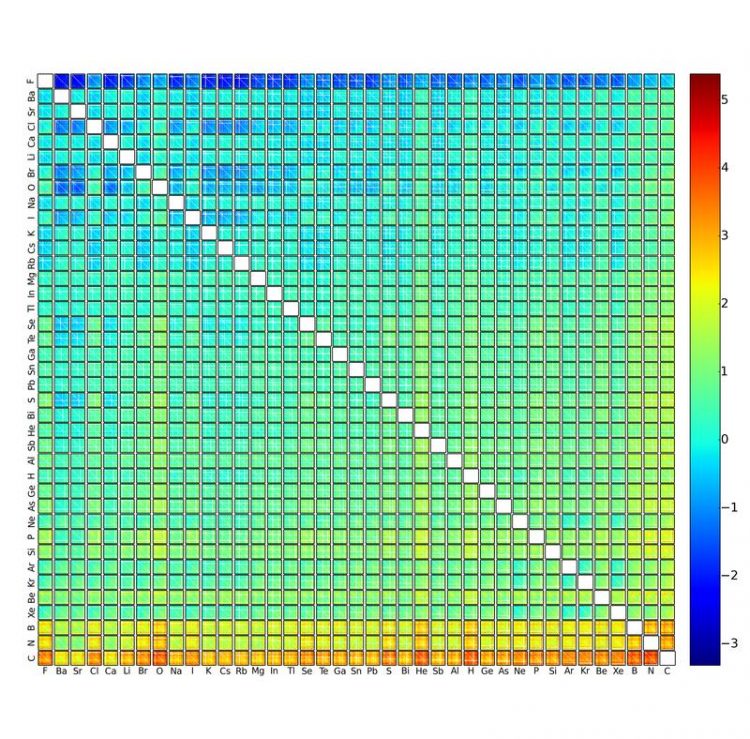Artificial Intelligence Helps in the Discovery of New Materials

The matrix depicts the formation energy – an indicator of stability – of around two million possible compounds. (Image: University of Basel, Department of Chemistry)
Elpasolite is a glassy, transparent, shiny and soft mineral with a cubic crystal structure. First discovered in El Paso County (Colorado, USA), it can also be found in the Rocky Mountains, Virginia and the Apennines (Italy). In experimental databases, elpasolite is one of the most frequently found quaternary crystals (crystals made up of four chemical elements).
Depending on its composition, it can be a metallic conductor, a semi-conductor or an insulator, and may also emit light when exposed to radiation.
These characteristics make elpasolite an interesting candidate for use in scintillators (certain aspects of which can already be demonstrated) and other applications. Its chemical complexity means that, mathematically speaking, it is practically impossible to use quantum mechanics to predict every theoretically viable combination of the four elements in the structure of elpasolite.
Machine learning aids statistical analysis
Thanks to modern artificial intelligence, Felix Faber, a doctoral student in Prof. Anatole von Lilienfeld’s group at the University of Basel’s Department of Chemistry, has now succeeded in solving this material design problem. First, using quantum mechanics, he generated predictions for thousands of elpasolite crystals with randomly determined chemical compositions.
He then used the results to train statistical machine learning models (ML models). The improved algorithmic strategy achieved a predictive accuracy equivalent to that of standard quantum mechanical approaches.
ML models have the advantage of being several orders of magnitude quicker than corresponding quantum mechanical calculations. Within a day, the ML model was able to predict the formation energy – an indicator of chemical stability – of all two million elpasolite crystals that theoretically can be obtained from the main group elements of the periodic table. In contrast, performance of the calculations by quantum mechanical means would have taken a supercomputer more than 20 million hours.
Unknown materials with interesting characteristics
An analysis of the characteristics computed by the model offers new insights into this class of materials. The researchers were able to detect basic trends in formation energy and identify 90 previously unknown crystals that should be thermodynamically stable, according to quantum mechanical predictions.
On the basis of these potential characteristics, elpasolite has been entered into the Materials Project material database, which plays a key role in the Materials Genome Initiative. The initiative was launched by the US government in 2011 with the aim of using computational support to accelerate the discovery and the experimental synthesis of interesting new materials.
Some of the newly discovered elpasolite crystals display exotic electronic characteristics and unusual compositions. “The combination of artificial intelligence, big data, quantum mechanics and supercomputing opens up promising new avenues for deepening our understanding of materials and discovering new ones that we would not consider if we relied solely on human intuition,” says study director von Lilienfeld.
The study is the product of a collaboration with physicists at Linköping University (Sweden) and was carried out under the auspices of the Swiss National Science Foundation’s National Center of Competence in Research as part of the MARVEL (Materials’ Revolution: Computational Design and Discovery of Novel Materials) project.
Original source
Felix Faber, Alexander Lindmaa, O. Anatole von Lilienfeld, and Rickard Armiento
Machine Learning Energies of 2M Elpasolithe (ABC2D6) Crystals
Physical Review Letters (2016), doi:10.1103/PhysRevLett.117.135502
Further information
Prof. Dr. O. Anatole von Lilienfeld, University of Basel, Department of Chemistry, Tel. +41 61 267 38 45, email: anatole.vonlilienfeld@unibas.ch
Media Contact
More Information:
http://www.unibas.chAll latest news from the category: Physics and Astronomy
This area deals with the fundamental laws and building blocks of nature and how they interact, the properties and the behavior of matter, and research into space and time and their structures.
innovations-report provides in-depth reports and articles on subjects such as astrophysics, laser technologies, nuclear, quantum, particle and solid-state physics, nanotechnologies, planetary research and findings (Mars, Venus) and developments related to the Hubble Telescope.
Newest articles

NASA: Mystery of life’s handedness deepens
The mystery of why life uses molecules with specific orientations has deepened with a NASA-funded discovery that RNA — a key molecule thought to have potentially held the instructions for…

What are the effects of historic lithium mining on water quality?
Study reveals low levels of common contaminants but high levels of other elements in waters associated with an abandoned lithium mine. Lithium ore and mining waste from a historic lithium…

Quantum-inspired design boosts efficiency of heat-to-electricity conversion
Rice engineers take unconventional route to improving thermophotovoltaic systems. Researchers at Rice University have found a new way to improve a key element of thermophotovoltaic (TPV) systems, which convert heat…



